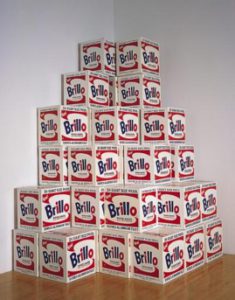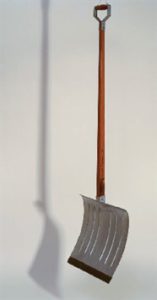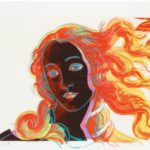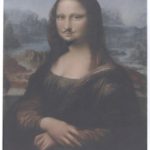Aurora Garrison | June 2018
One of Andy Warhol’s greatest artistic inspirations is the French Dadaist, Marcel Duchamp (1887 – 1968). Duchamp’s legacy is found in Warhol’s re-appropriation and artistic interpretation of common objects. Both Duchamp and Warhol challenge their audiences with the dual questions: what is art and what is good art? For example, Duchamp took a shovel and placed it in a French museum as a piece of art. Duchamp called these everyday objects ready-made art. Andy Warhol famously appropriated the Brillo box and elevated it from the grocery store shelf into art galleries. Duchamp and Warhol were challenging art critics and art audiences to articulate and defend what is art and what is not art.
In 1957, Duchamp created an especially modern self-portrait with paper collage.The artist’s profile peeks out through the negative space of the composition, perhaps as a way of presenting himself as an outlier in society. In his Self-Portrait, Duchamp uses bright blue and red inks silkscreened on black paper creating a striking effect. The result is so enticing and innovative that other prints from the edition were turned into posters to advertise his exhibition in 1959.
[visual_two_third]
Duchamp’s main goal through his “ready-made” art and sensational ideas is to provoke his contemporaries, his audience, and next generations. Similarly, Warhol, born 40 years after Duchamp, frequently uses his own image and that of celebrities and cultural icons to provoke and incite the American public.
Much like his predecessor, Warhol uses his image for a gallery exhibition, but promotes himself more than the exhibition itself and establishes himself as an iconic subject. With Warhol, his audience loves the art – but the artist is as colorful as his palette.
Warhol’s image and his art are magnified – a fact of which was entirely unprecedented for artists at the time and remains unrivaled today. In the late-1970s and into the 1980s, his self-portraits are more and more pervasive, due to his constant and indefatigable experimentation with different types of cameras and printing methods in their acceptance and enduring legacy.[/visual_two_third][visual_one_third_last]

[/visual_one_third_last]
Duchamp’s main goal through his “ready-made” art and sensational ideas is to provoke his contemporaries, his audience and next generations. Similarly, Warhol, born 40 years after Duchamp, frequently uses his own image and that of celebrities and cultural icons to provoke and incite the American public.
Much like his predecessor, Warhol uses his image for a gallery exhibition, but promotes himself more than the exhibition itself and establishes himself as an iconic subject. With Warhol, his audience loves the art – but the artist is as colorful as his palette.
Warhol’s image and his art are magnified – a fact of which was entirely unprecedented for artists at the time and remains unrivaled today. In the late-1970s and into the 1980s, his self-portraits are more and more pervasive, due to his constant and indefatigable experimentation with different types of cameras and printing methods in their acceptance and enduring legacy.
[visual_one_half]
The above Self-Portrait was published by the Leo Castelli Gallery and appropriated as an ad to announce Warhol’s exhibition at the gallery in 1966. Rather than a full silhouette like Duchamp’s self-portrait poster, Warhol’s gaze addresses the viewer straight on, but the lighting is so dramatic that one-half of his face is in shadow creating a silhouette of sorts. Warhol, familiar with the methods of advertising, printed this image on silver paper for extra flourish and flash. Aware of the role identity plays in society, both Duchamp and Warhol utilize the self-portrait trope and experiment with new art forms.
[/visual_one_half][visual_one_half_last]

[/visual_one_half_last]
Moving beyond the use of their own images, both artists select cultural icons as subject matter. Duchamp’s infamous L.H.O.O.Q.uses a reproduction of Leonardo da Vinci’s Mona Lisa, and draws a prankish mustache and goatee on her delicate face. In doing so, the artist transforms Mona Lisa from a she into a he, leaving it up to the viewer to see one gender, both genders or androgyny. Not only is there a visual playfulness in L.H.O.O.Q., but the title itself is a crude double entendre when pronounced in French and translates to “She has a hot ass” or “She has a fire down below.”
Comparably, Warhol continually re-appropriated classical artworks and redefined them in terms of popular culture. Although Botticelli’s original work of Venus has an elaborate background with her full body, Warhol decides to focus on Venus’ face. The Roman goddess of love is remade and given a dark complexion and flaming red hair, making the ancient goddess appear more like a 1980s pop singer. The two artists, both in their own, yet similar ways, present provocative portraits to the viewer. Both use well-known images and faces to raise issues of identity and portraiture that artists are still grappling with today.
Contemporary artists like Cindy Sherman and Damien Hirst are highly influenced by the experimental works of Warhol and Duchamp. Sherman, with her constructed self-portraits and experimental photography, and Hirst with his intense interest in cultural objects and multimedia strive to shock their audience. Similarly, to Warhol and Duchamp, Sherman and Hirst are driven by a need to provoke viewers and question what art should capture and express about the world around us.





